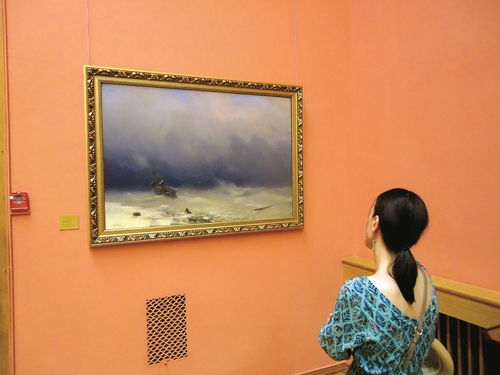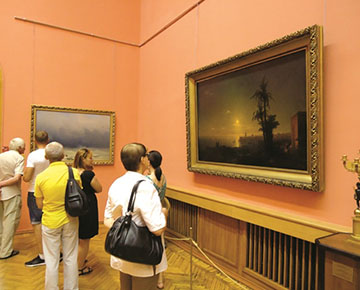To feel the ocean’s power or the tranquillity of a sea breeze on a sunny day, just visit the National Art Museum’s currently exhibition of works by prominent marine painter Ivan Aivazovsky. Space has been set aside for several pictures by Aivazovsky and other marine painters, conjuring waves breaking against a rugged coast, purple-red sunsets over the ocean, and clouds curled about the masts of ships.

“The sea is my life,” Ivan Aivazovsky once noted. His canvases comprise an encyclopaedia of the sea’s diversity. He wrote: ‘I’ve always felt, and continue to feel, the poetry of nature. I try to express everything with my brush: the charm of a southern night, the heavens, a southern sunset and the horror of a storm or hurricane. These inspire me to paint’.
The sea’s vast variations are fully reflected in his creativity: calm in such works as Misty Morning, Marina, and Morning at Sea; fascinating and mysterious in Moonlit Night in Amalfi, and Night on the Island of Rhodes; and or angrily rampant in Storm. Each state is depicted skilfully and poetically.
Aivazovsky wrote in his memoirs: ‘I create each plot for a picture in my head, as a poet conjures verse. Having made a sketch on a scrap of paper, I settle down to work and don’t leave my canvas until I’ve completely expressed myself with the brush’.

Undoubtedly, the romantic artist’s works almost always express strong emotions. Mr. Aivazovsky began his work in the first half of the 19th century but created most of his canvases in the second half of the century. Remarkably, at that time, his contemporaries preferred works by other masters, such as Alexey Bogolyubov and Rufin Sudkovsky, whose depictions were seen as more realistic, and less romantic. Even Aivazovsky’s pupil, Lev Lagorio, didn’t continue the romantic tradition. Like a number of his contemporaries, he was fond of simplicity of composition, and a restrained colour palette, as seen in his On The Seashore.
Art from the second half of the 19th century and the early 20th century is diverse, with various approaches co-existing in reflecting reality. Colour plays an important role in works by Nikolay Dubovsky, who is also represented at this exhibition. His pictures are light and simple, as in Seashore. Steamer. Sketch and The Sea Landscape, or may boast extreme depth and intensity, as in The Sea. In it he uses colour effectively.

Most artists from this time wished to portray nature realistically, without artificiality. Brilliant master of colour Vasily Surikov uses proportion and harmony in his watercolour Seashore. Crimea, painted in the open air. Meanwhile, Arkhip Kuindzhi’s Sea arouses the feeling of colour and the light becoming flesh.
Sharpness of perception and rejection of stereotypes is unique to Valentin Serov’s Amsterdam (1885), while Konstain Korovin, who spent much time painting near the sea, achieved unusual freshness and expression.
20th century painters grew fascinated by the open spaces of the North, many working beyond the Arctic Circle, to bring their own interpretation. The lead-grey waters skillfully depicted by Albert Benois in his On White Sea are mesmerizing. Leonard Turzhansky’s sea appears as an impenetrable wall in Northern Night. Murmansk Shore. Vitold Byalynitsky-Birulya gives us transluscent, pearl-blue spaces, and seashores sinking into the mist in Barents Sea. Herbert Silinsh’s To the Fishing Region is expressive and emotional. Each work conveys the harsh yet compelling beauty of the North.

Exhibition offers richly diverse portrayals of the sea
Other artists’ works explore the more southern seas, and warmer suns: Aristarkh Lentulov’s Morning in Batumi Harbour; Grigory Nissky’s Sevastopol. Embankment; Mikhail Kupriyanov’s Genichesk. Arabatskaya Strelka, and Genichesk. Fishermen’s Boats; and Nadir Kasumov’s Rocks. Sozopol.
Undoubtedly, the sea’s power is inspirational in its infinite diversity. Works by Ivan Aivazovsky, showing a romantic and emotional view of nature, as well as works by realists, and 20th century Impressionist-style canvases, reveal something new every time.
The current exhibition at the National Art Museum is remarkable in featuring works by Ivan Aivazovsky. His contemporaries recollected him completing a painting within just 90 minutes, in one sitting. Now, those who try to copy Aivazovsky take six months or longer to do so, making their ‘fakes’ obvious, since the paints dry as his never did.
The exhibition displays only original pieces from the museum’s collections, so it’s no wonder that art-lovers are flocking to view them. Masterpieces by Ivan Aivazovsky deserve to be admired, for their depiction of the deep beauty of the sea, the charm of sunlight and the softness of southern nights.
By Veniamin Mikheev











